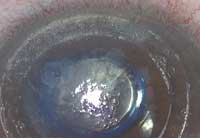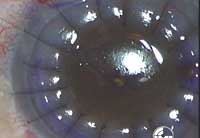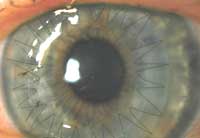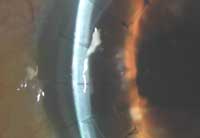Femtosecond lasers creating ‘revolutionary changes’ in corneal transplant surgery
The femtosecond laser has an unlimited ability for wound design, and the smoother and larger contact surface leads to faster healing.
|
|
LONDON — The use of femtosecond lasers is a revolutionary change in transplant surgery, according to two surgeons involved in U.S. and EU clinical trials for IntraLase- assisted penetrating keratoplasty.
“It’s an exciting time to be in corneal surgery. IntraLase is going to dramatically change the way we do corneal transplants,” said Francis W. Price Jr., MD, at the meeting of the European Society of Cataract and Refractive Surgeons.
Dr. Price was the first to perform a full-thickness procedure with IntraLase in a human eye in November 2005, following U.S. Food and Drug Administration approval.
Wound design
IntraLase has an unlimited ability for wound design, he said. So far, three types of configurations have been evaluated, and specific advantages for each one have been identified.
“The top-hat pattern allows reconstruction of corneas with thin peripheral recipient areas. The zigzag may give better initial wound closure in normal thickness corneas, so that it can be sutured in place with looser sutures than we were used to. The mushroom pattern is best in cases where we want to spare recipient endothelium, like in keratoconus patients,” Dr. Price said.
“Theoretically, you can customize the cut to meet the requirements of each individual patient,” he said.
In the first U.S. clinical study, involving four centers sharing the same prototype laser, 16 top-hat cases and six zigzag cases were included.
At the ESCRS meeting, Dr. Price presented the results of his first top-hat cases.
“The way the top hat works is the opposite of what you do mechanically,” he said. “The laser starts out with a vertical incision coming up from the posterior part of the cornea, then makes a horizontal stromal dissection and finally another vertical, anterior cut.”
U.S. trial: fast healing
The follow-up is less than 1 year, but preliminary results are exciting.
“These eyes heal a lot more quickly than with standard PK, because the healing takes place along each of the three steps of the incision, also along the vertical part. We do not see that normally. A more rapid healing means that the sutures do not need to be so tight, and can be removed earlier, reducing the problems of postoperative astigmatism,” Dr. Price said.
He showed the case of an 80-year-old patient who at 3 months had visible scarring along the suture track and the wound. Some fibrosis was present along the vertical part of the incision.
“In an 80-year-old who is on prednisolone acetate three times a day, this would never happen with a standard procedure,” he said.
Sutures were removed after 6 to 8 months in all cases, including a 95-year-old woman, although she was on prednisolone acetate four times a day.
“I’ve never seen anything like this in an elderly patient,” he said.
|
|
|
Images: Price FW |
A fast-moving technology
At the end of July, the IntraLase used in the study was upgraded with the first variation of the software, and some new cases are currently being performed with it.
Dr. Price said where the first prototype was placed in the operating area, he has now moved the upgraded system to a separate facility within the laser center.
“We do the IntraLase cut there, and then move the patient to the operating room where we do our standard transplant surgery on a different floor. Since the wounds separate easily, and this could happen when we move the patient from one place to another, we don’t completely intersect the incision planes with the laser. We leave them partially undone and then finish them off in the operating theater,” he said.
With the new upgraded system, five procedures have been performed, all top hat. Two were performed under topical anesthesia.
“In a short time we have seen advances that 30 years of corneal surgery had not even envisaged. The IntraLase is going to change dramatically the way we do corneal transplant,” he said.
EU trial: adapting the shape to the pathology
The surgeons involved in the first European study, carried out in five centers (Milan, Rome, Munich, Maastricht and London), are comparably enthusiastic about the results.
|
|
“We need longer follow-up, but femtosecond laser is the future of grafting. Lamellar or penetrating, this is the way to go,” said Lucio Buratto, MD.
He presented the results of seven eyes of seven patients operated in collaboration with Elisabetta Böhm, MD, in March. Five of these eyes had keratoconus and two had bullous keratopathy. In all these cases, the mushroom or inverted mushroom patterns were used.
“We adapted the shape of the graft to the specific needs of the pathologies we were treating. In the keratoconus patients we used the mushroom pattern, with a 9-mm anterior and 7-mm posterior surface, to have a large optical surface and preserve as much as possible of the healthy recipient’s endothelium,” Dr. Buratto said. “In the corneas with bullous keratopathy, we inverted the mushroom shape to have a 7-mm anterior and 9-mm posterior surface for better endothelial regeneration.”
Low astigmatism
At 3 months, a good relationship was established between graft and host, with an excellent adhesion and well-established healing process. All corneas were clear and the anterior chambers quiet.
“Refraction was good, except for the +11 D of a pseudophakic patient who had been implanted with a wrong IOL. In one case, we had 5 D of astigmatism, whereas in the other six cases the astigmatism ranged between 2 D and 3 D,” Dr. Buratto said.
Achieving such a low amount of astigmatism is “one of the biggest advantages of the procedure,” he said.
Mean best corrected visual acuity was 20/32, ranging between 20/60 and 20/20.
Patient satisfaction was high, Dr. Buratto said. Two of the patients had standard PK in the other eye and said the femtosecond procedure was less traumatic, with a more rapid and comfortable recovery.
“There is a definite difference between standard and IntraLase PK in the days and months that follow surgery,” Dr. Buratto said. “Postoperatively, these eyes are very quiet, with no sign of inflammation or edema, and healing comes fast and natural. After 6 months, we have already started removing the sutures,” Dr. Buratto said.
For more information:
- Francis W. Price Jr., MD, can be reached at Price Vision Group, 9002 N. Meridian St., Suite 100, Indianapolis, IN 46260 U.S.A.; +1-317-814-2823; fax: +1-317-844-5590.
- Lucio Buratto, MD, can be reached at Centro Ambrosiano di Microchirurgia Oculare, Piazza Repubblica 21, 20124 Milan, Italy; +39-02-6361191; fax: +39-02-6598875; e-mail: office@buratto.com.
- IntraLase Corp., maker of the IntraLase FS femtosecond laser, can be reached at 9701 Jeronimo Road, Irvine, CA 92618 U.S.A.; +1-949-859-5230; Web site: www.intralase.com.
- Michela Cimberle is an OSN Correspondent based in Treviso, Italy, who covers all aspects of ophthalmology. She focuses geographically on Europe.






